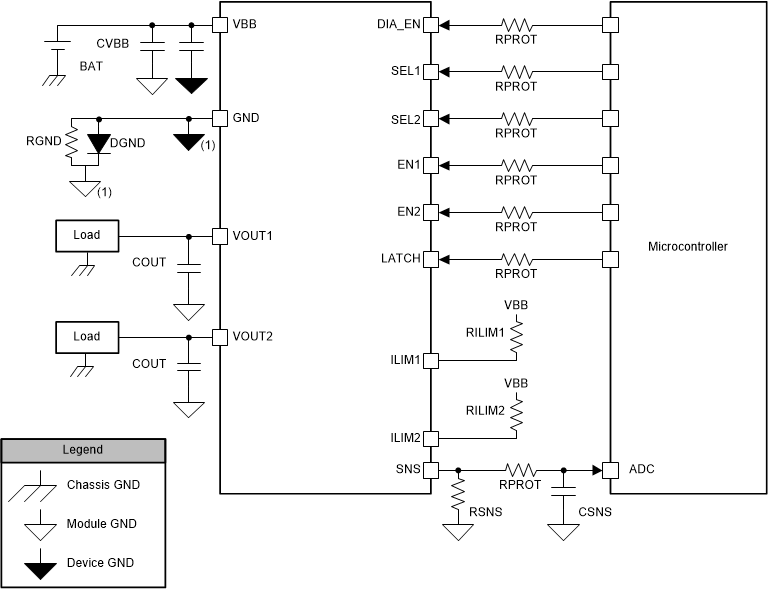JAJSHA8A February 2018 – April 2019 TPS2HB50-Q1
ADVANCE INFORMATION for pre-production products; subject to change without notice.
- 1 特長
- 2 アプリケーション
- 3 概要
- 4 改訂履歴
- 5 Device Comparison Table
- 6 Pin Configuration and Functions
- 7 Specifications
- 8 Parameter Measurement Information
-
9 Detailed Description
- 9.1 Overview
- 9.2 Functional Block Diagram
- 9.3
Feature Description
- 9.3.1 Protection Mechanisms
- 9.3.2 Diagnostic Mechanisms
- 9.4 Device Functional Modes
- 10Application and Implementation
- 11Power Supply Recommendations
- 12Layout
- 13デバイスおよびドキュメントのサポート
- 14メカニカル、パッケージ、および注文情報
10.1 Application Information
Figure 15 shows the schematic of a typical application for the TPS2HB50-Q1. It includes all standard external components. This section of the datasheet discusses the considerations in implementing commonly required application functionality.

1. With the ground protection network, the device ground will be offset relative to the microcontroller ground.
Figure 15. System Diagram Table 12. Recommended External Components
| COMPONENT | TYPICAL VALUE | PURPOSE |
|---|---|---|
| RPROT | 15 kΩ | Protect microcontroller and device I/O pins |
| RSNS | 1 kΩ | Translate the sense current into sense voltage |
| CSNS | 100 pF - 10 nF | Low-pass filter for the ADC input |
| RGND | 4.7 kΩ | Stabilize GND potential during turn-off of inductive load |
| DGND | BAS21 Diode | Protects device during reverse battery |
| RILIM | 5 kΩ - 25 kΩ | Set current limit threshold |
| CVBB | 220 nF to Device GND | Filtering of voltage transients (for example, ESD, ISO7637-2) and improved emissions |
| 100 nF to Module GND | Stabilize the input supply and filter out low frequency noise. | |
| COUT | 22 nF | Filtering of voltage transients (for example, ESD, ISO7637-2) |
| CGND | 1 µF from Device GND to Module GND | Optional capacitance to help with RF immunity. |